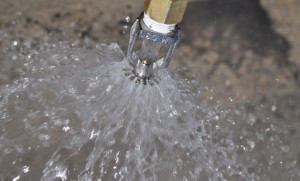
Fire and flooding are ever-present dangers for most facilities. An incident involving high-value equipment or stock is often a large financial loss for any business, large or small. The thought of process interruption or stock loss causes great stress to facility managers and staff and can interrupt business/production. A significant loss might involve not only high values, but might result in the permanent loss of a facility.
SPRINKLER OVERVIEW
Automatic sprinklers are designed to suppress a fire until the fire department can fully extinguish the fire. Sprinkler systems are designed to specifications contained in the National Fire Protection Association’s (NFPA) standard 13, “Standard for the Installation of Sprinkler Systems.” This standard is referenced in all major building and fire codes and is subject to regular revisions. Recently, the standards have gone into greater depth to specify specific design criteria related to sprinkler size, coverage, response speed, occupancy, location, layout and required water supply. The sprinkler system designer, maintenance contractor and building occupants all need to be cognizant of the hazards and requirements associated with their occupancy and commodity.
Sprinkler systems are maintained to NFPA 25 “Standard for the Inspection, Testing and Maintenance of Water-Based Fire Protection Systems.” It is the building owner’s responsibility to ensure the requirements are met or that an appropriate contractor is hired to complete the work. Improper maintenance often results in the failure of a sprinkler system. To minimize the potential for system failure, this standard calls out the specific requirements for routine inspection and testing of water supplies, fire pumps, supply tanks, system valves, system piping and sprinklers. In addition to the sprinkler system standard, NFPA 72 has additional requirements for the design, installation and maintenance of fire alarm systems, including the sprinkler system’s waterflow alarms. NFPA 25 and NFPA 72 each specify requirements for sprinkler and alarm systems that are not functional (or are impaired) to ensure a safe level of fire protection is reliably maintained.
COMMON MODES OF FAILURE
When a fire sprinkler system is not properly designed, it can fail, causing catastrophic results in the form of flooding or, if a fire occurs, the sprinkler system may be ill-equipped to suppress it. We have investigated fires in large warehouses where the fire sprinkler system was inadequate for the materials being stored. The building configuration and the commodity stored had changed a number of times and the suppression system was overlooked. The resulting fires proved too much for the underpowered sprinkler systems.
Even the most well-designed fire sprinkler systems are only as reliable as the maintenance that is performed on them. Without proper maintenance, sprinkler systems are susceptible to premature failure, lack of reliability, leaks and freezing. In cold climates, for example, sprinkler systems are often designed to include an antifreeze mixture in the pipes. If not properly maintained, the antifreeze can dilute to the point that it is also susceptible to freezing. Another type of freeze-protected system is a dry-pipe sprinkler system, in which the piping is intended to contain pressurized air instead of water (until water is needed). While extremely effective in preventing freeze failures, these types of systems require adequate maintenance or they are likely to freeze and cause significant flooding.
A commonly-voiced concern about sprinkler systems is the potential for water damage from the sprinkler system. While there is a risk, the risk is minimal compared to the benefits the system provides. In the event of a fire, the presence of a properly designed and maintained sprinkler system can limit water damage by controlling the fire and preventing spread to other areas. This may allow the fire department to limit their use of water to extinguish the fire. Inadvertent sprinkler activations in properly designed and maintained systems are rare.
WHAT QUESTIONS SHOULD EMPLOYERS ASK?
- Is your sprinkler system properly designed for your facility?
- Have you kept up with regular maintenance of your system?
- When is the last time your system was tested?
- Have your needs changed since your system was installed?
THE ROLE OF A FIRE PROTECTION ENGINEER
Unified’s Fire Protection Engineers are knowledgeable in all aspects of facility fire protection: sprinklers, water supplies, alarm systems, special hazard protection systems and emergency response. Prior to a loss, we offer services such as verifying the adequacy of an existing system, reviewing the layout of a system or commodity, or checking maintenance that has been performed. If a fire or flood event has occurred, we will perform a hazard analysis, verify the effectiveness of the system and augment fire origin and cause investigations. In terms of subrogation and liability, we often are able to accurately analyze all of the factors and parties involved to provide our client a broad and accurate picture of what led up to the event.
Unified’s Fire Protection Engineers are uniquely trained and experienced to evaluate existing systems as well as activated or failed systems to determine the cause and contributing factors. What questions can we answer for you about fire protection?
Fire Protection Engineering Team, Unified Investigations & Sciences, a Sedgwick company
- Angela Brown, MS, PE, Fire Protection Engineer
- Adam Farnham, MS, PE, Senior Fire Protection Engineer
- Jay Kramarczyk, MS, PE, Fire Protection Engineering Team Lead
- Ronald Langstaff, PE, Fire Protection Engineer